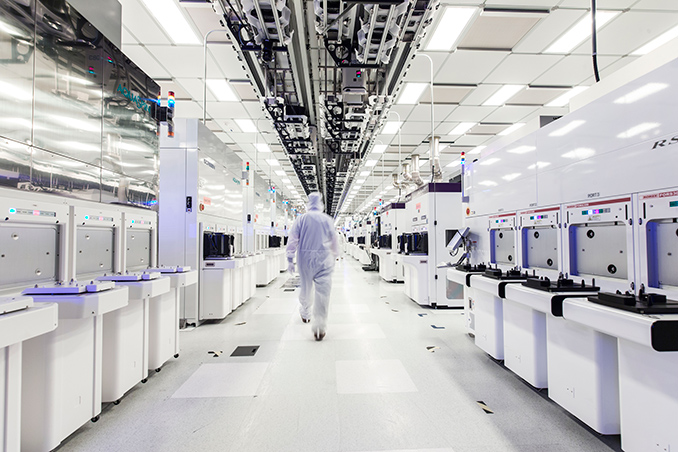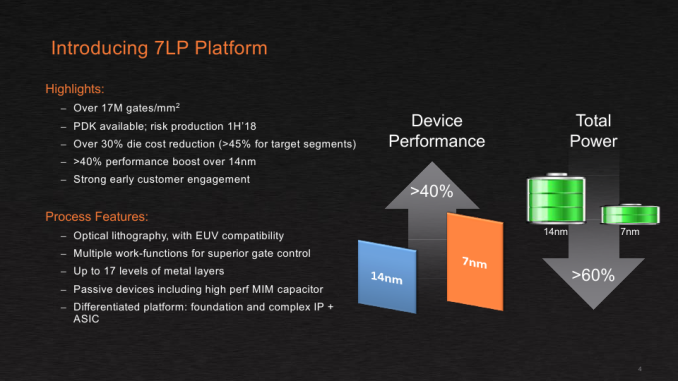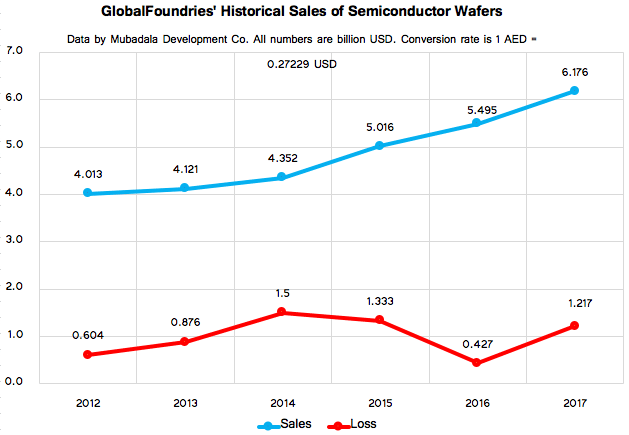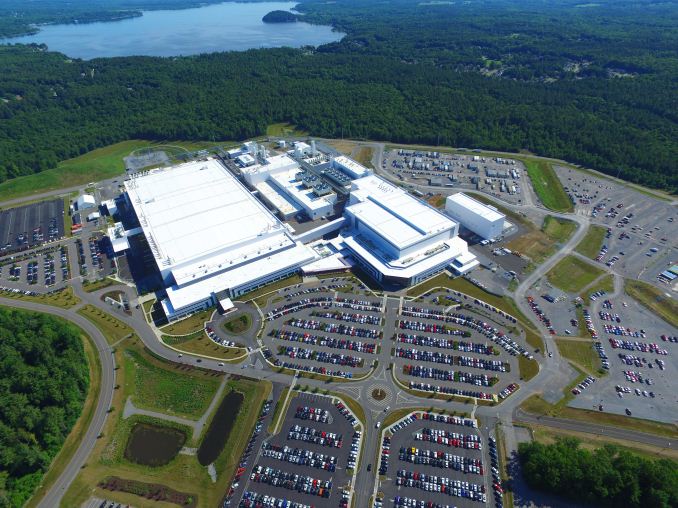GlobalFoundries Stops All 7nm Development: Opts To Focus on Specialized Processes
by Anton Shilov & Ian Cutress on August 27, 2018 4:01 PM EST- Posted in
- Semiconductors
- CPUs
- AMD
- GlobalFoundries
- 7nm
- 7LP

GlobalFoundries on Monday announced an important strategy shift. The contract maker of semiconductors decided to cease development of bleeding edge manufacturing technologies and stop all work on its 7LP (7 nm) fabrication processes, which will not be used for any client. Instead, the company will focus on specialized process technologies for clients in emerging high-growth markets. These technologies will initially be based on the company’s 14LPP/12LP platform and will include RF, embedded memory, and low power features. Because of the strategy shift, GF will cut 5% of its staff as well as renegotiate its WSA and IP-related deals with AMD and IBM. In a bid to understand more what is going on, we sat down with Gary Patton, CTO of GlobalFoundries.
7LP Canned Due to Strategy Shift
GlobalFoundries was on track to tape out its clients’ first chips made using its 7 nm process technology in the fourth quarter of this year, but “a few weeks ago” the company decided to take a drastic, strategic turn, says Gary Patton. The CTO stressed that the decision was made not based on technical issues that the company faced, but on a careful consideration of business opportunities the company had with its 7LP platform as well as financial concerns.
It is noteworthy that when GlobalFoundries first announced its 7LP platform in September 2016, it said that it would start risk production of processors using this technology in early 2018 (PR), which means that the first chips should have been taped out before that. When the company detailed the process in June 2018, it said that it expected to start “volume production ramping in the second half of 2018” (PR), which would be close to impossible if customers taped out their first chips only in Q4.
Generally, it looks like the company had to adjust its roadmap somewhere along the way, moving the start of high-volume manufacturing (HVM) further into 2019. Whether or not these adjustments had any implications on GlobalFoundries is up to debate. Keep in mind that AMD’s first 7 nm product was designed for TSMC’s CLN7FF from the beginning, so the company did not bet on GF’s 7LP in late 2018 anyway, and no rush with the manufacturing technology was needed for GF’s key customer.
Along with the cancellation of the 7LP, GlobalFoundries essentially canned all pathfinding and research operations for 5 nm and 3 nm nodes. The company will continue to work with the IBM Research Alliance (in Albany, NY) until the end of this year, but GlobalFoundries is not sure it makes sense to invest in R&D for ‘bleeding edge’ nodes given that it does not plan to use them any time soon. The manufacturer will continue to cooperate with IMEC, which works on a broader set of technologies that will be useful for GF’s upcoming specialized fabrication processes, but obviously it will refocus its priorities there as well (more on GF’s future process technologies later in this article).
So, the key takeaway here is that while the 7LP platform was a bit behind TSMC’s CLN7FF when it comes to HVM – and GlobalFoundries has never been first to market with leading edge bulk manufacturing technologies anyway – there were no issues with the fabrication process itself. Rather there were deeper economic reasons behind the decision.
Economic Reasons Behind the Move
As we noted in our article covering GlobalFoundries's new CEO hire earlier this year, former CEO Sanjay Jha was never able to make the company profitable. His key tasks were to increase GlobalFoundries’s sales, streamline the company in general, and ensure that it executes its roadmap.
To address the needs of the manufacturer’s traditional key client (AMD) and ensure that his company was competitive against other contract makers of semiconductors, he licensed Samsung Foundry's 14LPP fabrication technology. That strategy worked well. With Sunjay Jha at the helm, GlobalFoundries has managed to land a variety of new customers and increase its sales of semiconductor wafers from approximately $4.121 billion in 2013 to $6.176 billion in 2017. Besides, the foundry’s leading-edge Fab 8, which has been processing wafers using exclusively 14LPP process technology for well over 1.5 years now, is running at full capacity.
To ensure that GlobalFoundries remains competitive against Samsung Foundry and TSMC in the long run, Sunjay Jha obtained IP and development teams from IBM (along with two fabs and a lot of obligations), and poured in billions of dollars in development of the 7LP fabrication technology platform. The latter would include three generations of manufacturing processes and, possibly, a custom high-performance technology available exclusively to IBM. While everything appeared to proceed smoothly with the 1st Gen 7 nm process (DUV only), the 2nd Gen 7 nm process (with EUV used for non-critical layers, such as padding) still needed some additional development investments, and the 3rd Gen 7 nm (with intensive usage of EUV) required even more money for development and further could require installation of additional EUV equipment. Meanwhile, there were two things to consider.
First. If GlobalFoundries kicks off production using the 1st Gen 7 nm fabrication process, it would have needed to cure all of its teething troubles and offer its clients a roadmap forward. The latter would have included 2nd Gen and 3rd Gen 7 nm, but nothing stops there. Customers would have asked for 5 nm and then for 3 nm nodes. Meanwhile, you cannot tell your clients that you are packing up after a certain node and then hope that this node will be a success (the same is true for DUV-only 1st Gen 7 nm).
Second. Development of leading-edge process technologies is extremely expensive. Every new node requires billions of dollars in investments. Those costs are eventually amortized over each chip the company makes, so to keep increasing R&D costs from driving up chip prices, foundries need to produce more chips. To make more chips, they need to either run multiple fabs that use the same process technology (these are going to cost $10+ billion in the EUV era), or build giant fabs that process a gargantuan number of wafers (these are going to cost $20+ billion in the EUV era). Meanwhile, GlobalFoundries has only one leading-edge fab featuring capacity of 60,000 wafer starts per month. As a result, either GlobalFoundries has to pass these R&D costs on to the finite number of wafers it processes – and become uncompetitive against rivals in the process – or eat the costs with reduced profitability.
Meanwhile, having spent well over $20 billion on GlobalFoundries over the last 10 years, Mubadala, the owner of the company, is not inclined to lose more money or invest tens of billions in the hopes of becoming profitable one day. The investor wants GlobalFoundries to stop bleeding and start generating profits.
“The culture of [our investments], the ones I’ve been involved with, was about accumulating assets and then just maintaining it,” said Mubadala CEO Khaldoon Al Mubarak in an interview with Bloomberg earlier this year. “The shift that has happened over the last couple of years, that I’ve tried to push at Mubadala today, is a monetization strategy that makes sense, not with a view to cash out but with a view to reinvest.”
Gary Patton admits that GlobalFoundries never planned to be a leading producer of 7-nm chips in terms of volume. Furthermore, the company has been seeing increasing adoption of its 14LPP/12LP technologies by designers of various emerging devices, keeping Fab 8 busy and leaving fewer step-and-scan systems for 7LP products.
Without another big fab, it would be impossible to make any new leading-edge process technology competitive against Samsung and TSMC due to aforementioned scale reasons. Meanwhile, building a new fab (or even expanding the Fab 8 with another clean room module, which is something that GF considered several years ago) and creating another node or two would require another $10 – $15 billion from Mubadala, which is not inclined to invest just now. As a result, the GlobalFoundries has decided to switch entirely to specialized process technologies for emerging high-growth markets. This strategic shift enables it to reduce spending on R&D, slowdown procurement of new equipment, reduce its workforce by 5% (most of which will be in Malta), and potentially avoid direct competition against the aforementioned contract makers of semiconductors.













127 Comments
View All Comments
phoenix_rizzen - Monday, August 27, 2018 - link
It's mentioned in the article that AMD is targetting TSMC 7nm.eastcoast_pete - Tuesday, August 28, 2018 - link
That's one of the open questions here. 80% of TSMC's 7 nm capacity is contractually bound for Apple's needs, leaving precious few wafers for everybody else. eetimes published an interesting article on this a few days ago. Basically, players like Qualcomm and Huawei (HiSilikon) will likely have to get chummy with Sammy if they want their 855 Snapdragon in 7 nm in usable quantities, because Samsung is now the only other fab operator supposedly close or ready for 7 nm. I do wonder where all the other 7 nm silicon for EPYCs, Ryzens, and assorted GPUs is supposed to come from now with GloFo out. AFAIK, TSMC is currently the only player with a 7 nm fab fully up-and-running, and that fab is very busy (and contractually obligated) to make all the A12 chips it can. So, this pull-back by GloFo is great news for Samsung; wouldn't surprise me if their stock just jumped a bit.BurntMyBacon - Tuesday, August 28, 2018 - link
Good news for Samsung, sure. However, they are only an option for AMD if they can get the yields up. Historically, Samsung's process has been competitive with other contract fabs. Though (if I recall correctly), they've struggled with larger chips. ARM chips targeted at phone should be good (they need that for their own chips), but larger ARM chips targeted at servers and larger GPUs have historically been problematic. It is uncertain if large, high performance x86 chips would work out well. If Apple moved a large portion of their orders to Samsung, then TSMC might have the capacity to service all these larger chips. However, with so much of the TSMC capacity tied up by Apple, AMD will likely need to prioritize either CPUs or GPUs. Given recent history, I suspect they will favor server CPU production and probably back down on high end GPUs. Perhaps we'll get another round of smaller mid-range GPUs fabricated at Samsung. Unless Samsung suddenly develops proficiency for fabricating larger chips or TSMC suddenly frees up significant capacity, I suspect this bodes very poorly for competition in high end GPUs.dogzilla - Monday, August 27, 2018 - link
I think they are saying that the company isn't big enough to pay for the investment to continue process development at 7 nm and below. You have to make enough wafers to spread the development cost around, and they are just too small, make too few wafers. I worked at companies that have made this same decision, it's called a going out of business strategy. Any customers that might need to migrate to 7 nm and smaller will move elsewhere, usually they are the more profitable customers.Zoomer - Tuesday, August 28, 2018 - link
Exactly. What are you going to sell in 5, 10, 15 years time?PhrogChief - Monday, August 27, 2018 - link
'Strategical' is NOT a word.levizx - Tuesday, August 28, 2018 - link
And the Earth is flat.https://www.dictionary.com/browse/strategical
https://www.thefreedictionary.com/strategical
V900 - Monday, August 27, 2018 - link
*CRASMASH!*That’s the sound of Moore’s law colliding with physics.
A few years ago, an ex-Intel buffin held a talk on chipmaking at the end of Moore’s law. He predicted it would come at 2016-2020 and around 10nm.
That’s really it then. We’ll get another node at 7nm (eventually) but after that? Slow, incremental improvement.
Few people understand how big of a deal this is, but think about this. All of us grew up in a world where the power and speed of computers and electronics would double roughly every two years.
This exponential growth was a virtual certainty and it fed the biggest prosperity engine in human history. There isn’t many fields and businesses that didn’t in some way benefit from it.
And that’s almost over. There’s a few years left where it almost seems like nothing has changed, but it has.
Some of us have children. Those children won’t live in a world with electronics doubling in speed and capability every few years.
The next generation of video games for them will look pretty much like the last one, unless you’ll know where to look.
For them, it’ll be nothing but slow, incremental improvement year after year: A 2% improvement here. A 1% improvement there. The way it was before the transistor.
The scariest thing is, what will happen to the economy. Trillions of dollars and billions of man hours have been spent in the shadow of Moore’s law the past decades. What will happen, once there isn’t a reason to get a new TV every 4 years? If computers only get a few percent faster every year, will computers become a thing you buy once a decade?
nevcairiel - Monday, August 27, 2018 - link
I don't think the future is quite as grim quite yet. After 7nm there is still EUV for a few more nodes (probably 5 and 3nm, and maybe even 1nm). Thats probably over a decade right there.Maybe in that time, someone will finally figure out an alternative. Carbon-based solutions have been mysteriously hyped for a long time. Graphene transistors? Carbon nanotubes?
Manch - Tuesday, August 28, 2018 - link
"Some of us have children. Those children won’t live in a world with electronics doubling in speed and capability every few years."Oh....the.....horror.....